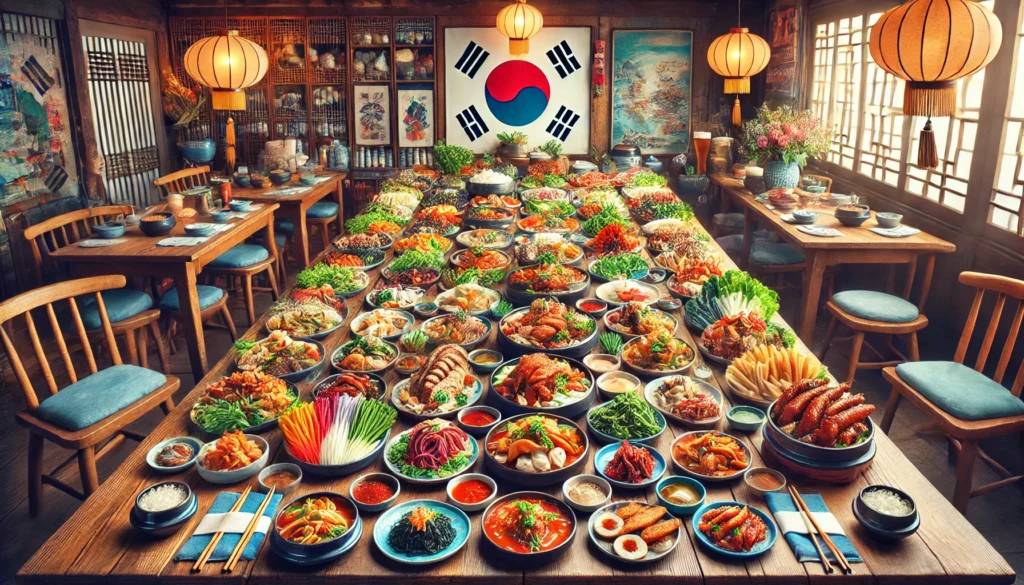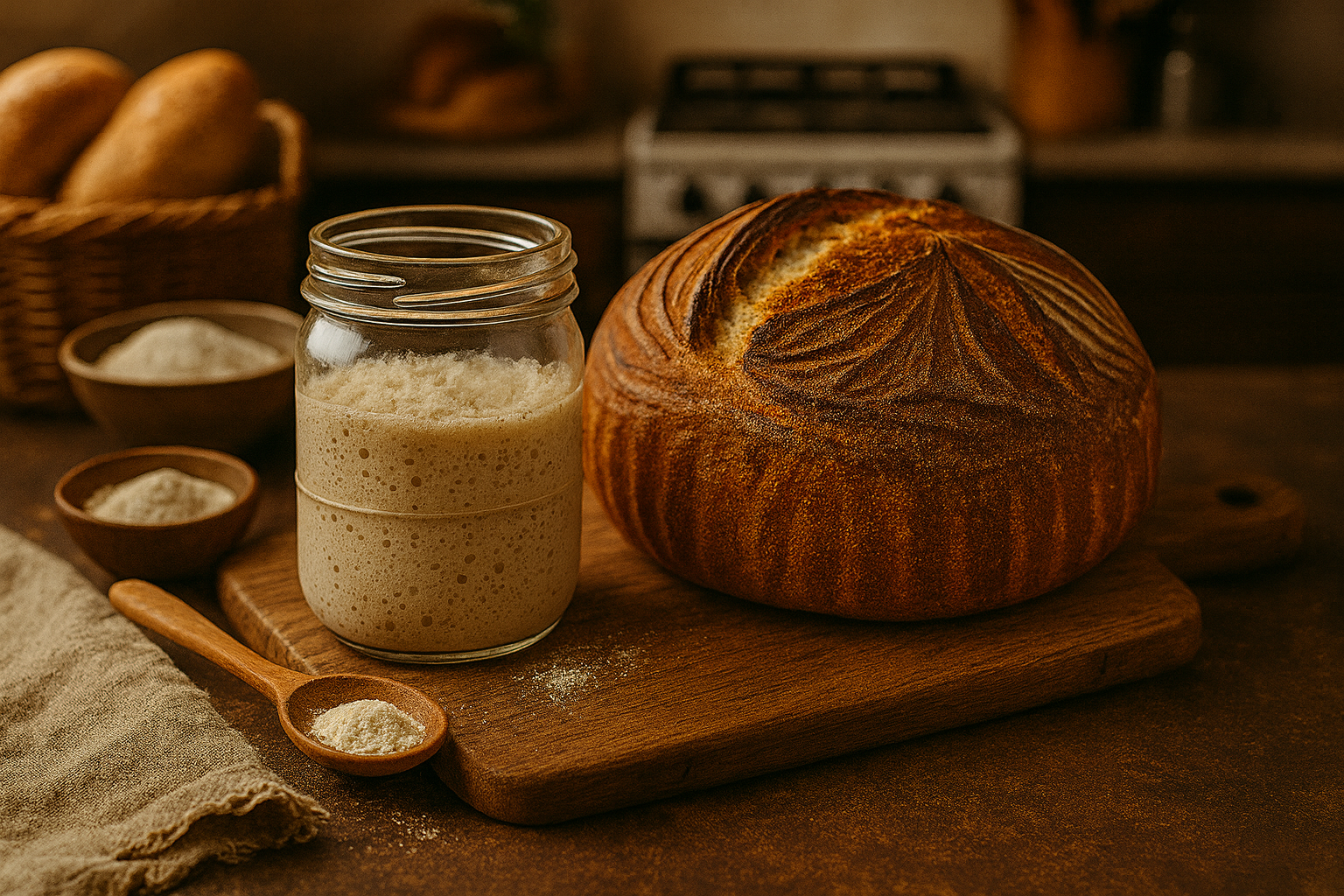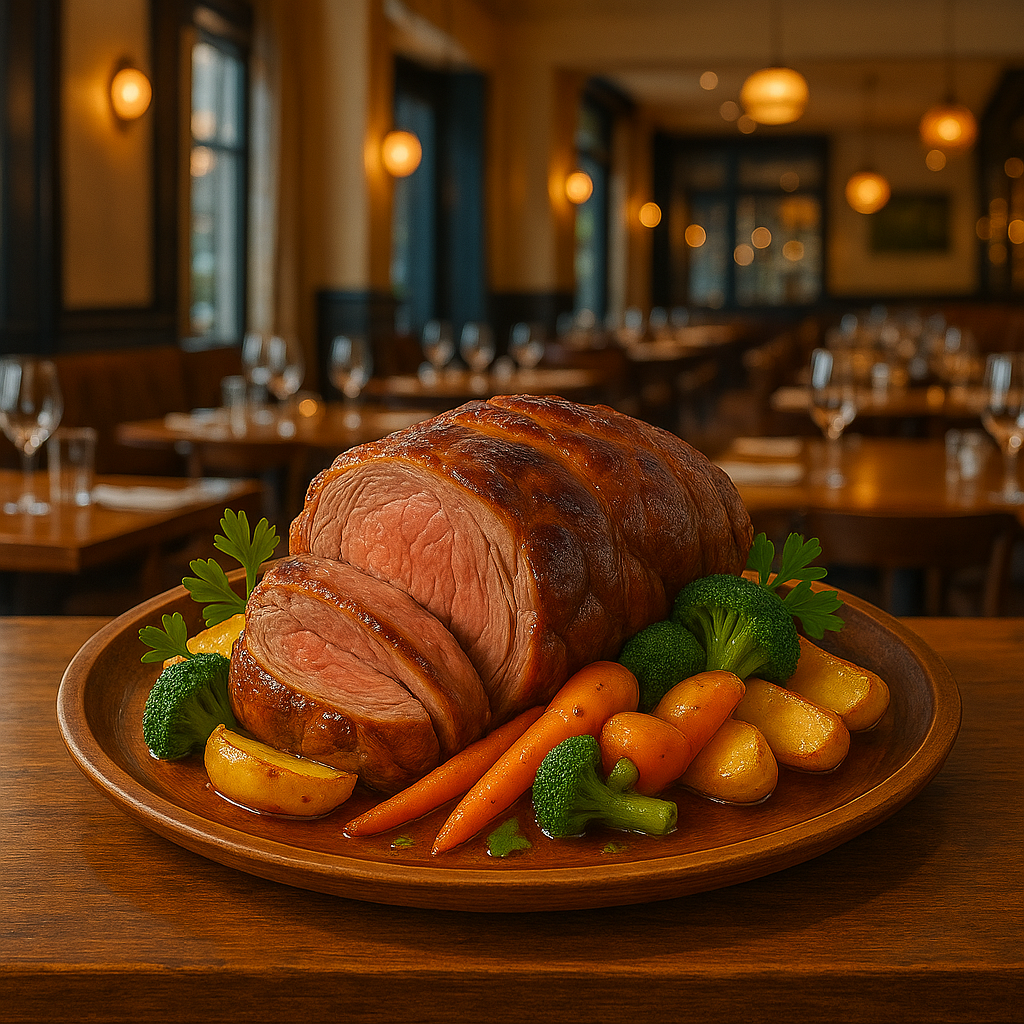Table of Contents
Introduction to Korean Cuisine
Korean cuisine is widely recognized for its rich flavors, vibrant ingredients, and unique culinary traditions that reflect the cultural heritage of South Korea. Rooted in a history that spans millennia, Korean food not only satisfies hunger but also holds great significance within social and familial circles. Communal dining is a hallmark of Korean culture, where meals are often enjoyed together, fostering connection and camaraderie among family and friends.
The interplay of flavors in Korean dishes is remarkable, characterized by a harmonious balance between savory, sweet, spicy, and sour elements. Essential ingredients such as gochujang (red chili paste), doenjang (fermented soybean paste), and sesamum indicum (sesame oil) create a depth of taste that is distinctive to this cuisine. This intricate blend makes each dish a vibrant and flavorful experience, inviting diners to appreciate the complexities of each ingredient and the methods of preparation.
Freshness is a key principle in Korean cooking, where locally sourced vegetables, meats, and seafood are used to create wholesome meals. Seasonal ingredients play a pivotal role in the culinary landscape, ensuring that every dish captures the essence of South Korea’s diverse environment. Moreover, traditional Korean cuisine has undergone significant evolution over the years, influenced by historical events, globalization, and changing dietary habits. Contemporary Korean cuisine often incorporates international flavors and techniques, resulting in innovative dishes that remain grounded in tradition.
This evolution exemplifies the dynamic nature of Korean culinary arts, showcasing how past and present blend to form a uniquely modern yet deeply traditional food culture. As we delve into the various dishes that define South Korea’s rich culinary scene, it is essential to appreciate the profound cultural significance of food in this vibrant society.
Bibimbap: The Ultimate Mixed Rice Dish
Bibimbap is one of South Korea’s quintessential dishes, celebrated not only for its rich flavors but also for its vibrant presentation. The term “bibimbap” translates to “mixed rice,” and this dish comprises a bowl of warm rice topped with a variety of sautéed and seasoned vegetables, usually including carrots, zucchini, and spinach. A primary protein component, often marinated and cooked beef, enhances the dish’s savory profile. To complete the dish, a fried egg is typically placed on top, and gochujang, a spicy red chili paste, is added according to personal taste. The combination creates a symphony of flavors and textures, appealing to both the palate and the eyes.
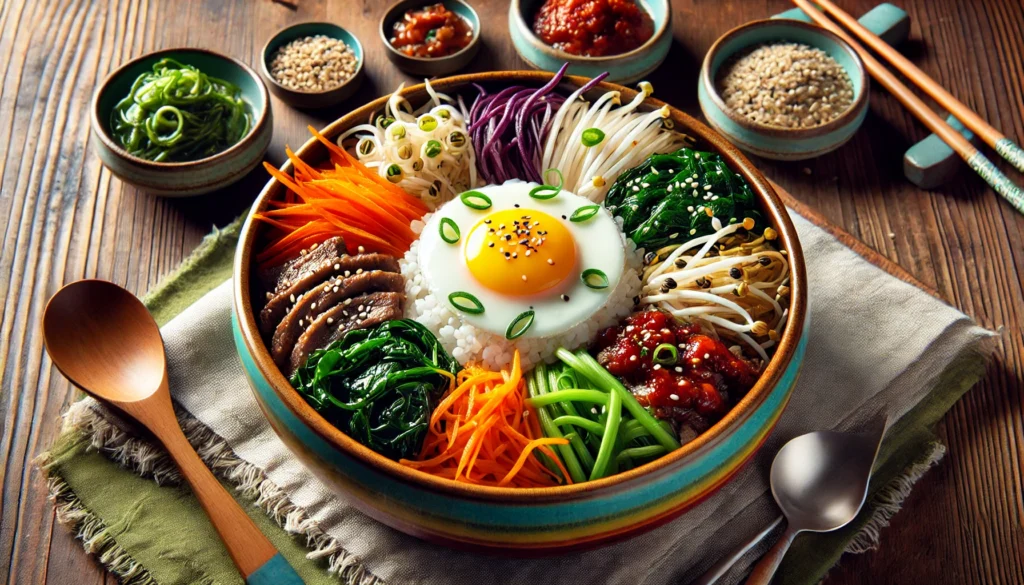
While the core components of bibimbap remain consistent, regional variations abound throughout South Korea. For instance, in Jeonju, the city renowned as the birthplace of bibimbap, the dish features more premium ingredients, including a variety of mushrooms and injeolmi, a type of rice cake. Other regions offer their unique twists; for example, the seaside towns might incorporate fresh seafood into their bibimbap, enhancing the dish’s overall appeal even further. The wide array of ingredients utilized can vary significantly, reflecting the rich agricultural diversity of South Korea and highlighting local flavors.
For those looking to indulge in this iconic dish, many eateries across South Korea serve excellent bibimbap. Traditional Korean restaurants, known as “hanok,” often provide the most authentic experience, where diners can enjoy bibimbap alongside side dishes such as kimchi. Markets, food stalls, and street vendors also serve hearty portions of this beloved dish, allowing visitors a chance to experience bibimbap in its many forms. No visit to South Korea would be complete without savoring this ultimate mixed rice dish.
Kimchi: The National Side Dish
Kimchi holds a revered place in South Korean cuisine, regarded as the national side dish that accompanies nearly every meal. This fermented vegetable dish, typically made from napa cabbage and Korean radishes, is seasoned with a mix of spices, garlic, ginger, and, most notably, gochugaru (red chili pepper flakes), which give it a distinctively spicy flavor. The versatility of kimchi is evident in the multitude of varieties, with at least 200 different types recognized, showcasing everything from bok choy to cucumbers, each tailored to regional and seasonal ingredients.
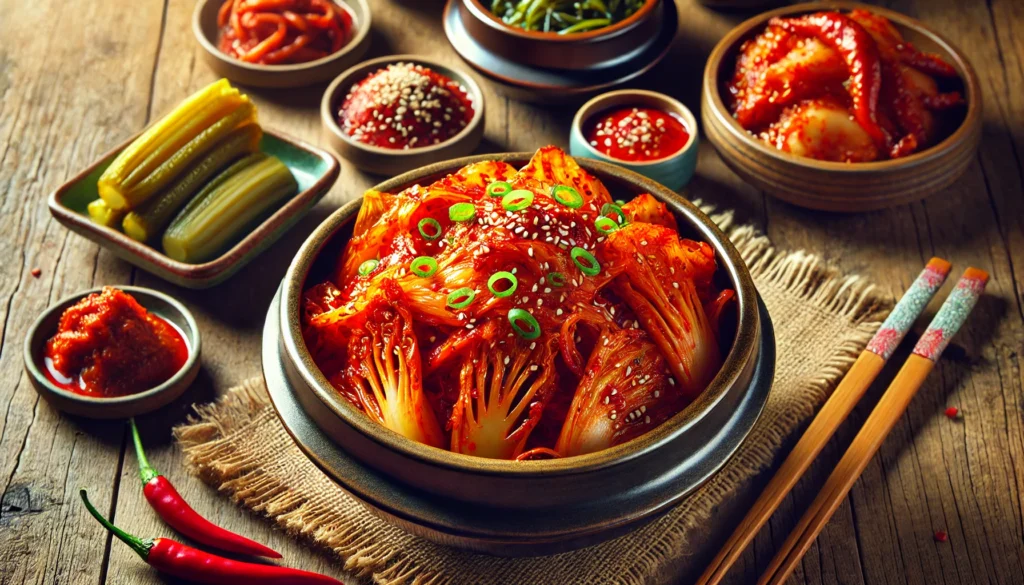
The fermentation process is at the heart of kimchi’s appeal, which not only enhances its flavor but also introduces beneficial probiotics. This process begins with the careful salting of the vegetables, drawing out moisture and creating an environment conducive to fermentation. The seasoned vegetables are then packed tightly into jars or containers, often sealed to prevent air exposure, allowing them to ferment at room temperature for several days before being stored in the refrigerator. This traditional technique is not merely about preservation; it infuses kimchi with rich, complex flavors that evolve over time.
Beyond its taste, kimchi is renowned for its health benefits. Rich in vitamins A, B, and C, as well as being a source of dietary fiber, it supports digestive health and boosts the immune system. The fermentation process also increases the bioavailability of nutrients, making them easier for the body to absorb. In Korean culture, kimchi embodies the spirit of community and family, often prepared in large batches during the fall harvest in a practice known as ‘kimjang.’ This cultural tradition strengthens familial bonds and emphasizes the importance of sharing food.
In South Korea, kimchi is not just a food item but a symbol of national identity, celebrated for its taste and health properties. For anyone exploring Korean cuisine, experiencing kimchi in its various forms is essential.
Korean BBQ: An Interactive Dining Experience
Korean BBQ, or “gogi-gui,” is more than just a meal; it is a cultural experience that emphasizes communal dining and social interaction. At the heart of this culinary tradition is the practice of grilling various types of meat, such as galbi (short ribs) and samgyeopsal (pork belly), right at your table. This interactive method of cooking not only enhances the flavors through direct heat but also fosters a sense of togetherness among diners.
When you visit a traditional Korean BBQ restaurant, you will find that the grilling is often done on a built-in tabletop grill. This setup allows you to cook the meat to your preferred level of doneness while enjoying the process with friends or family. Galbi, marinated in a sweet and savory sauce, is a favorite for many, offering a delightful balance of flavors. On the other hand, samgyeopsal is served unmarinated, allowing the natural taste of the pork to be highlighted as it is grilled to perfection.
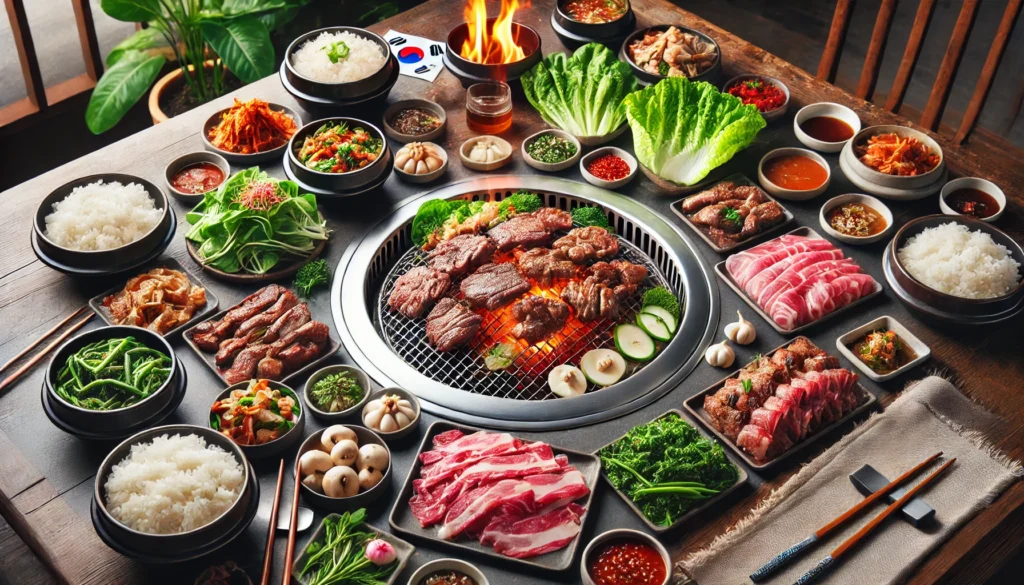
A typical Korean BBQ meal is accompanied by an array of banchan, which are small side dishes that enhance the dining experience. These can include kimchi, pickled vegetables, and seasoned tofu, among others. The variety of banchan provides different textures and flavors, making each bite exciting and unique. The shareable nature of these dishes encourages guests to sample a wide range of tastes, contributing to a vibrant meal atmosphere.
For those looking to explore the best Korean BBQ restaurants, establishments such as Maple Tree House in Seoul and All That Barbecue provide an excellent dining experience, featuring quality ingredients and a variety of meat options. Whether you are a first-time visitor or a seasoned foodie, indulging in Korean BBQ is an essential part of South Korea’s culinary landscape that should not be overlooked.
Tteokbokki: Spicy Rice Cake Delight
Tteokbokki is a popular South Korean street food known for its unique combination of chewy rice cakes, fish cakes, and a variety of savory and spicy sauces. This dish has its origins in the royal court cuisine of Korea, dating back to the Joseon Dynasty, where it was served as a delicacy in traditional celebrations. Over time, tteokbokki evolved from its auspicious beginnings and transformed into a beloved snack available at street stalls, markets, and casual eateries across the nation.
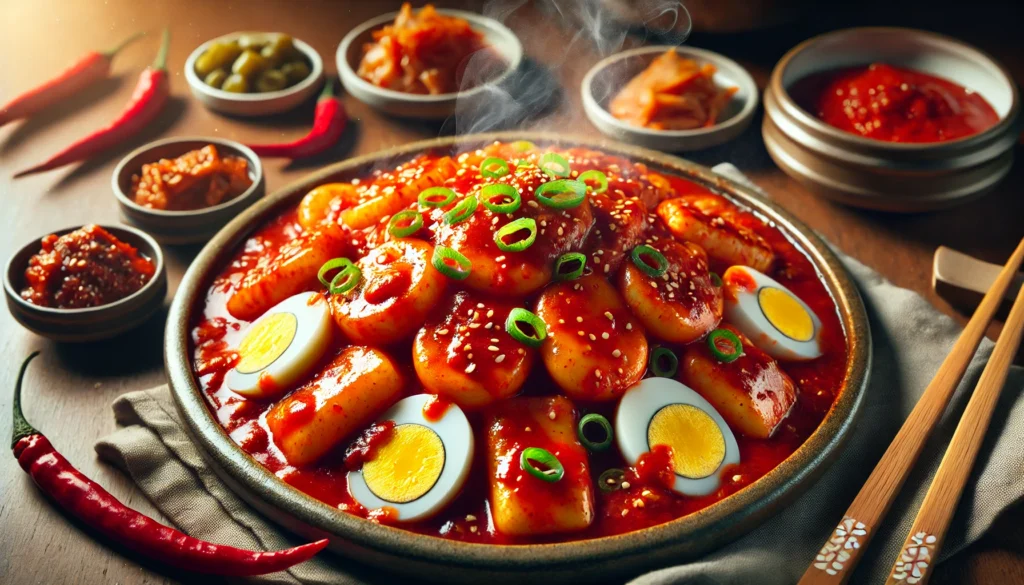
The traditional version of tteokbokki features cylindrical rice cakes, commonly known as *tteok*, which are made from glutinous rice. These cakes are typically simmered in a homemade sauce comprising gochujang, a spicy red pepper paste, along with ingredients such as soy sauce, sugar, and garlic, which contribute to its distinctively rich flavor. Variations of tteokbokki have emerged over the years, featuring additional ingredients like vegetables, boiled eggs, seafood, and even cheese, reflecting the evolving tastes of a global audience while maintaining its culinary roots.
For those looking to sample tteokbokki, the bustling markets in South Korea are among the best places to find this spicy delight. Notable destinations include Gwangjang Market in Seoul, where visitors can enjoy freshly made tteokbokki from a myriad of vendors. Additionally, the vibrant street food scene in Myeongdong showcases numerous stalls that serve this delicious snack, often paired with fried snacks like *odeng* (fish cakes) for a satisfying meal. Whether enjoyed on the go or seated at a market table, tteokbokki remains an essential experience for anyone exploring Korean cuisine.
Japchae: Sweet Potato Noodle Stir-Fry
Japchae, a beloved dish in Korean cuisine, features sweet potato noodles, known as dangmyeon, which lend a unique chewy texture to the stir-fry. These transparent noodles are made from sweet potato starch and are naturally gluten-free, making them a delightful alternative for those with dietary restrictions. The primary preparation method involves soaking the noodles in warm water until softened, followed by boiling them briefly to achieve the perfect consistency. Once prepped, the noodles are stir-fried with a vibrant mix of sautéed vegetables, which typically include carrots, spinach, and bell peppers. Some variations introduce beef or other proteins, enhancing the dish’s rich flavors.
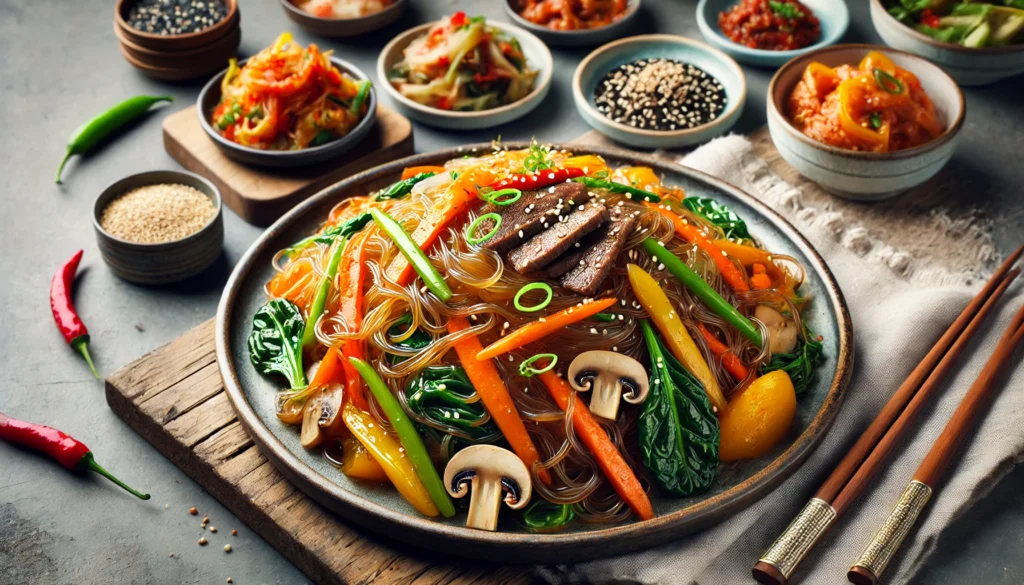
Japchae is synonymous with Korean celebrations and gatherings, often served during birthdays, weddings, and holidays such as Chuseok (Korean Thanksgiving). It embodies the spirit of sharing and community in Korean culture, making it a staple dish at festive events. Its appealing presentation, characterized by the colorful array of vegetables, is an inviting sight on any dining table. The subtle sweetness of the sweet potato noodles, combined with the umami of soy sauce and the aromatic essence of sesame oil, creates a harmonious balance that is both satisfying and delicious.
For those seeking a vegetarian-friendly version, japchae can easily be adapted. Simply omit any meat components and increase the variety of vegetables used. Options such as mushrooms, zucchini, and even tofu can add depth and protein to the dish without compromising its integrity. By using a mixture of light and dark soy sauce, along with sesame oil for seasoning, the dish can maintain its authentic flavors while catering to vegetarian diets. Thus, japchae remains a versatile and popular choice, cherished by many across different occasions.
Sundubu-jjigae: Spicy Tofu Stew
Sundubu-jjigae is a renowned Korean dish that features uncurdled tofu, known as sundubu. This hot and spicy stew is characterized by its rich and savory broth, which can be enhanced by the addition of various ingredients such as seafood, vegetables, or meat, typically including clams, shrimp, or beef. The dish is particularly popular during colder seasons due to its warming qualities and the pleasure derived from consuming a steaming bowl of stew on chilly days.
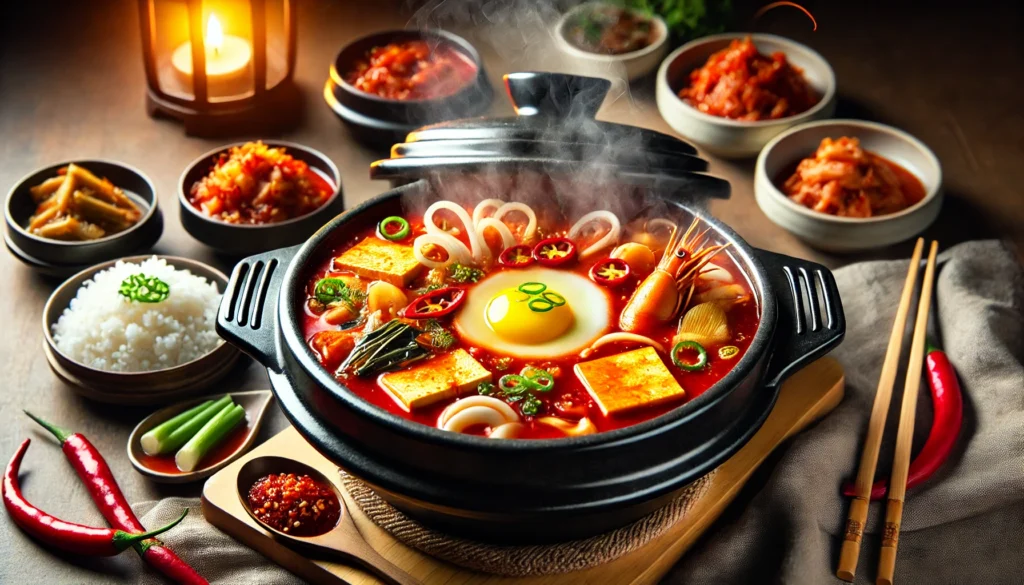
Variations of sundubu-jjigae can be found throughout South Korea, with regional adaptations that cater to local tastes. For example, some may prefer a version with added ingredients like kimchi or mushrooms for a unique flavor profile. The spiciness of the dish can also be adjusted according to personal preference, allowing for a customized experience. Additionally, a common garnish for sundubu-jjigae is a raw egg, which is often added just before serving, providing a creamy texture and enriching the overall taste.
Typically served in a stone pot, sundubu-jjigae is often accompanied by a bowl of steamed rice and a selection of banchan, or side dishes, that complement the main course. The combination of textures and flavors in sundubu-jjigae makes it a satisfying meal, while its nutritious ingredients contribute to its reputation as a comfort food. This dish not only offers a delightful culinary experience but also showcases the fundamental aspects of Korean cuisine, such as the use of fresh ingredients and bold flavors. A bowl of sundubu-jjigae can serve as a reminder of the warmth of Korean hospitality, making it a dish that captures the essence of South Korean dining culture.
Korean Fried Chicken: A Crispy Sensation
Korean fried chicken has gained international acclaim for its unique preparation methods and delectable flavors. This beloved dish is distinguished by its double-fried technique, which imparts a remarkably crispy exterior while maintaining juicy, tender meat on the inside. This process involves frying the chicken twice, creating a light and airy batter that holds up exceptionally well against various sauces and seasonings.
One of the most popular variations of Korean fried chicken is yangnyeom, which translates to “seasoned” chicken. This flavorful option is coated in a delectable sweet and spicy sauce, made from ingredients like gochujang (Korean red chili paste), soy sauce, garlic, and sugar. The combination of these flavor profiles creates a mouthwatering balance, appealing to a wide range of palates. Other popular sauces include garlic soy, honey mustard, and even more innovative options like cheese or curry, showcasing the dish’s versatility.

Another noteworthy aspect of Korean fried chicken is its cultural significance and the rising trend of pairing it with beer. Known as “chimaek,” the marriage of chicken and beer has become a popular choice among locals and tourists alike. Many establishments in South Korea specialize in this perfect pairing, often offering a variety of craft beers that complement the crispiness of the chicken. This trend contributes to the overall dining experience, making it a preferred social activity and a quintessential part of Korean culinary culture.
As you explore South Korea, indulging in the country’s renowned fried chicken is an experience that cannot be overlooked. Whether you’re enjoying it at a bustling street stall or a modern restaurant, Korean fried chicken stands out as a must-try dish, renowned for its enticing flavors and satisfying crunch.
Street Desserts: Sweet Treats to Indulge In
Korean street food is renowned not only for its savory dishes but also for an array of delectable desserts that can be found at stalls and markets throughout the country. These street desserts, particularly bingsu, hotteok, and tteok, showcase the variety and richness of Korean culinary traditions, offering unique flavors and textures that are sure to tantalize any food lover’s palate.
One of the most beloved street desserts in South Korea is bingsu, a refreshing dessert made from finely shaved ice. Traditionally, it is topped with sweetened condensed milk, fruit, and sometimes red bean paste. Modern variations often include ingredients such as matcha powder, chocolate syrup, and a range of seasonal fruits, offering a multitude of flavor combinations. The preparation of bingsu involves the careful shaving of frozen blocks of ice, resulting in a fluffy texture that quickly melts in the mouth, making it an ideal treat during hot summer days. Its cultural significance lies in its ability to bring people together, often enjoyed in groups during social outings.

Hotteok, on the other hand, is a popular winter treat characterized by its sweet, doughy exterior filled with a mixture of brown sugar, cinnamon, and chopped nuts. This delightful pancake is cooked on a griddle until golden brown and crispy, providing a warm contrast to the sweet filling. The preparation of hotteok involves mixing flour, water, and yeast, allowing it to rise before it is filled with the sweet mixture and fried. This street dessert’s origins date back to Chinese immigrants in the late 19th century and have since become a staple of Korean culture. Enjoying hotteok during the cold months symbolizes warmth and comfort.
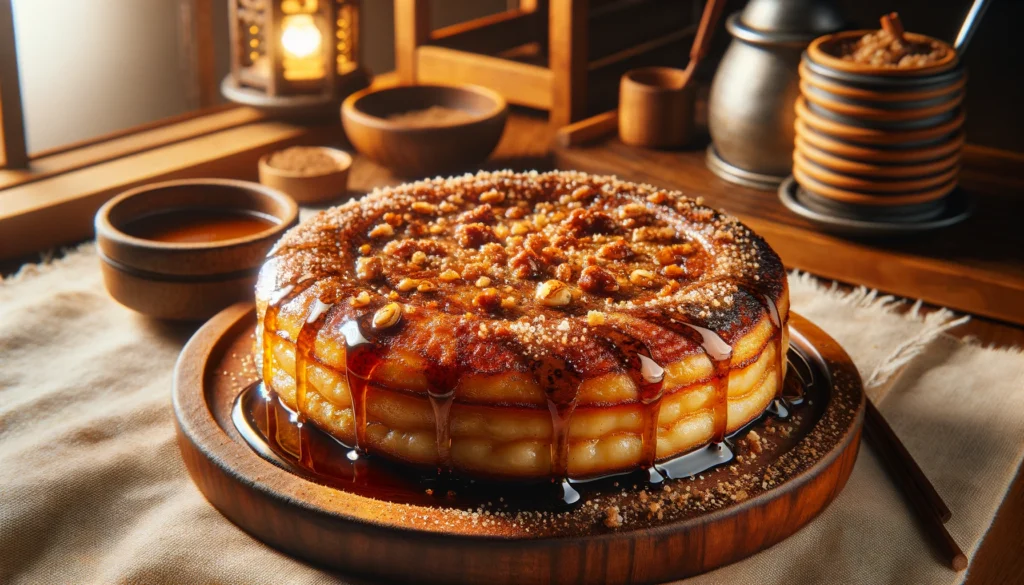
Tteok, a traditional rice cake, is another essential part of Korean street dessert offerings. Made from glutinous rice, tteok can be enjoyed in various forms, ranging from chewy and sweet to soft and flavorful. Popular variations include injeolmi, which is coated in powdered soybean flour, and songpyeon, which is often filled with sweetened sesame or red bean paste. Tteok plays a significant role in Korean celebrations and rituals, symbolizing good fortune and prosperity.

Exploring these sweet Korean street desserts is an essential part of experiencing the country’s vibrant food culture. With their rich flavors, comforting textures, and cultural heritage, bingsu, hotteok, and tteok are simply not to be missed for any food enthusiast visiting South Korea.
